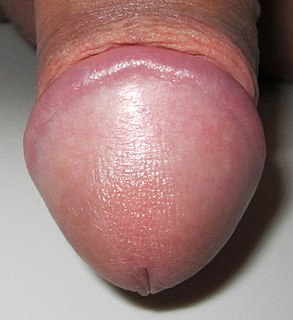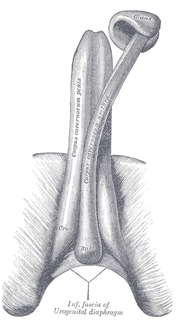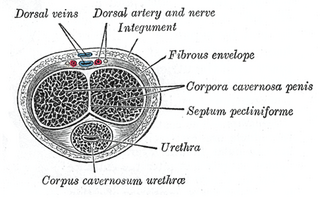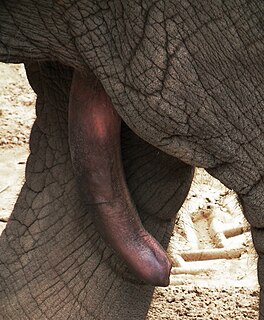
The clitoris is a female sex organ present in mammals, ostriches and a limited number of other animals. In humans, the visible portion – the glans – is at the front junction of the labia minora, above the opening of the urethra. Unlike the penis, the male homologue (equivalent) to the clitoris, it usually does not contain the distal portion of the urethra and is therefore not used for urination. The clitoris also usually lacks a reproductive function. While few animals urinate through the clitoris or use it reproductively, the spotted hyena, which has an especially large clitoris, urinates, mates, and gives birth via the organ. Some other mammals, such as lemurs and spider monkeys, also have a large clitoris.

Erectile dysfunction (ED), also called impotence, is the type of sexual dysfunction in which the penis fails to become or stay erect during sexual activity. It is the most common sexual problem in men. Through its connection to self-image and to problems in sexual relationships, erectile dysfunction can cause psychological harm.

The glans penis, commonly referred to as the glans, is a structure at the distal end of the penis in male mammals. It is the sensitive bulbous structure at the end of the human penis, and is anatomically homologous to the clitoral glans of the human female. The glans penis may be smooth, spiny, elongated, or divided in other mammals.

Priapism is a condition in which a penis remains erect for hours in the absence of stimulation or after stimulation has ended. There are three types: ischemic (low-flow), nonischemic (high-flow), and recurrent ischemic (intermittent). Most cases are ischemic. Ischemic priapism is generally painful while nonischemic priapism is not. In ischemic priapism, most of the penis is hard; however, the glans penis is not. In nonischemic priapism, the entire penis is only somewhat hard. Very rarely, clitoral priapism occurs in women.

In female human anatomy, the clitoral hood is a fold of skin that surrounds and protects the glans of the clitoris; it also covers the external shaft of the clitoris, develops as part of the labia minora and is homologous with the foreskin in male genitals. The clitoral hood is composed of muccocutaneous tissues; these tissues are between the mucosa and the skin, and they may have immunological importance because they may be a point of entry of mucosal vaccines. The clitoral hood is also important not only in protection of the clitoral glans, but also in pleasure, as it is an erogenous tissue.

Penis enlargement, or male enhancement, is any technique aimed to increase the size of a human penis. Some methods aim to increase total length, others the shaft's girth, and yet others the glans size. Techniques include surgery, supplements, ointments, patches, and physical methods like pumping, jelqing, and traction.
Phalloplasty is the construction or reconstruction of a penis, or the artificial modification of the penis by surgery. The term 'phalloplasty' is also occasionally used to refer to penis enlargement.

The baculum is a bone found in the penis of many placental mammals. It is absent in the human penis, but present in the penises of other primates, such as the gorilla and chimpanzee. The os penis arises from primordial cells within soft tissues of the penis, and its formation is largely under the influence of androgens. The bone is located above the male urethra, and it aids sexual reproduction by maintaining sufficient stiffness during sexual penetration. The homologue to the baculum in female mammals is known as the baubellum or os clitoridis, a bone in the clitoris.

Semen collection refers to the process of obtaining semen from human males or other animals with the use of various methods, for the purposes of artificial insemination, or medical study. Semen can be collected via masturbation, prostate massage, artificial vagina, penile vibratory stimulation (vibroejaculation) and electroejaculation. Semen can be collected from endangered species for cryopreservation of genetic resources.

The bulbus glandis is an erectile tissue structure on the penis of canid mammals. During mating, immediately before ejaculation the tissues swell up to lock (tie) the male's penis inside the female. The locking is completed by circular muscles just inside the female's vagina; this is called "the knot" tightening thus preventing the male from withdrawing. The circular muscles also contract intermittently, which has the effect of stimulating ejaculation of sperm, followed by prostatic fluid, as well as maintaining the swelling of the penis and therefore the tie, for some time. For domestic dogs the tie may last up to half an hour or more, though usually less. When male canines are excited, the bulbus glandis may swell up inside the penile sheath, even if the dog has been neutered.

A corpus cavernosum penis (singular) is one of a pair of sponge-like regions of erectile tissue, which contain most of the blood in the penis during an erection.
Canine reproduction is the process of sexual reproduction in domestic dogs, wolves, coyotes and other canine species.

The corpus cavernosum of clitoris is one of a pair of sponge-like regions of erectile tissue that contain most of the blood in the clitoris during clitoral erection. This is homologous to the corpus cavernosum penis in the male; the body of the clitoris contains erectile tissue in a pair of corpora cavernosa, with a recognizably similar structure.
Venous leak, also called venogenic erectile dysfunction and penile venous insufficiency, is one category of vasculogenic impotence -a cause of erectile dysfunction in males. It affects all ages, being particularly awkward in young men. Much about venous leaks has not reached a consensus among the medical community, and many aspects of the condition, particularly its treatment strategies, are controversial. The prevalence of the condition is still unknown, although some sources claim it to be a common cause of erectile dysfunction.

The human penis is an external male intromittent organ that additionally serves as the urinal duct. The main parts are the root (radix); the body (corpus); and the epithelium of the penis including the shaft skin and the foreskin (prepuce) covering the glans penis. The body of the penis is made up of three columns of tissue: two corpora cavernosa on the dorsal side and corpus spongiosum between them on the ventral side. The human male urethra passes through the prostate gland, where it is joined by the ejaculatory duct, and then through the penis. The urethra traverses the corpus spongiosum, and its opening, the meatus, lies on the tip of the glans penis. It is a passage both for urination and ejaculation of semen

A penis is the primary sexual organ that male animals use to inseminate females during copulation. Such organs occur in many animals, both vertebrate and invertebrate, but males do not bear a penis in every animal species, and in those species in which the male does bear a so-called penis, the penises in the various species are not necessarily homologous.

An erection is a physiological phenomenon in which the penis becomes firm, engorged, and enlarged. Penile erection is the result of a complex interaction of psychological, neural, vascular, and endocrine factors, and is often associated with sexual arousal or sexual attraction, although erections can also be spontaneous. The shape, angle, and direction of an erection varies considerably in humans.

Clitoral erection is a physiological phenomenon where the clitoris becomes enlarged and firm.
An intromittent organ is a general term for an external organ of a male organism that is specialized to deliver sperm during copulation. Intromittent organs are found most often in terrestrial species, as most non-mammalian aquatic species fertilize their eggs externally, although there are exceptions. For many species in the animal kingdom, the male intromittent organ is a hallmark characteristic of internal fertilization.

Many mammalian species have developed keratinized penile spines along the glans and/or shaft, which may be involved in sexual selection. These spines have been described as being simple, single-pointed structures (macaques) or complex with two or three points per spine (strepsirrhines). Penile spine morphology may be related to mating system.
















